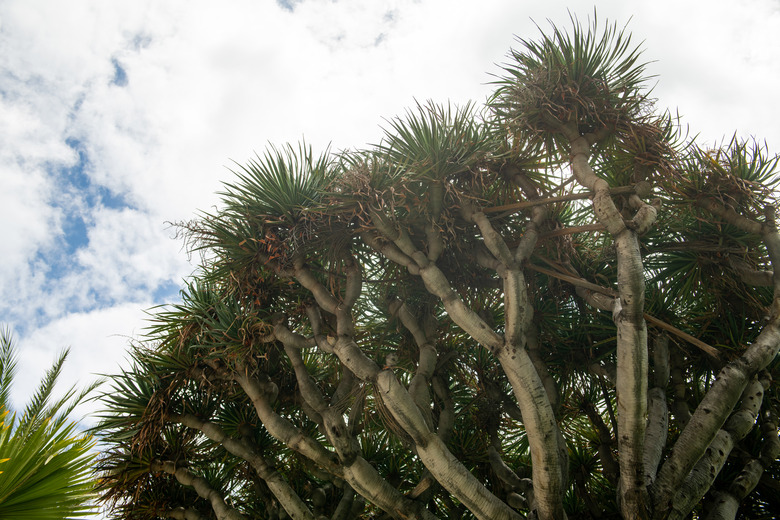How To Take Cuttings From A Dragon Plant
We may receive a commission on purchases made from links.
Dragon tree (Dracaena draco), which grows in U.S. Department of Agriculture plant hardiness zones 9 through 11, comes from the Canary Islands. Thick, gray stems slowly grow into a branching tree 20 or 30 feet tall. This plant gives its name to the entire genus Dracaena, which contains about 150 species and many cultivars.
Although the name dragon tree loosely applies to all members of this genus, including the corn plant, only a few have it as part of their common name, such as Madagascar dragon tree (Dracaena marginata), which grows in USDA zones 10b through 11. Many dracaenas are toxic to pets. You can propagate dragon trees from cuttings, but technique is important to your success.
Dracaena Tip Cuttings
Dracaena Tip Cuttings
A tip cutting is the stem end that contains the terminal head of leaves. Take cuttings in spring or early summer when the plant is growing actively. If you are repotting the plant, it may be handy to do it them. Wipe the pruning shears with a cloth soaked in rubbing alcohol to prevent spreading disease. Cut the stem a few inches below the last leaves of the head of leaves in a thin-stemmed plant such as Madagascar dragon tree.
For larger plants with thicker stems, leave a length of cane below the leaves to make a stem for the rooted cutting plus several inches that will be put into the rooting mix. Lucky bamboo (Dracaena sanderiana), which grows in USDA zones 10 through 11, can be propagated from tip cuts, with young shoots trained into interesting forms before they harden.
Dracaena Cane Cuttings
Dracaena Cane Cuttings
A dragon plant often forms cane cuttings when you prune back stems to keep the plant to size or to encourage branching. Cut the cane into shorter sections, about 3 inches long, marking the bottom of each section. Use 4-inch-wide pots with drainage holes. For vertical cutting placement, fill the pots with a moistened mixture of equal parts peat moss and perlite. Insert the cutting into the mix with the bottom side down and at least one node under the potting mix. Nodes are the places where leaves emerge or have emerged from the stems. For horizontal placement, lay the cutting on its side on the potting mix so one-half of the stem is buried.
Rooting Dragon Plant Cuttings
Rooting Dragon Plant Cuttings
Place the potted cuttings in an area with bright, indirect light. Keep the potting mix moist but not soggy. Occasionally check for rooting by tugging the cane gently. When it resists moving, roots are forming from the nodes buried under the soil. Shoots also grow from the above-ground nodes. The canes root more quickly if you put the pots on a propagation mat that gently heats the bottom of the pot.
Dragon Tree Cuttings
Dragon Tree Cuttings
If you have an older, branching dragon tree, you can try stem cuttings. The plants take 10 years to reach 3 feet tall and don't branch until they're about 20 years old. Use a pruning saw wiped with rubbing alcohol to remove a branch up to 3 feet long during summer, cutting just above a node. Put the leafless bottom of the stem into a sandy rooting mix and stake it so it remains upright and doesn't move. Place it in full sun and wait for it to root. The stem bleeds red sap, historically called dragon's blood, when wounded. It's an ingredient in the varnish used for violins.
References
- Floridata: Dracaena Draco
- University of Florida IFAS Extension: Dracaena Marginata Red-Edged Dracaena, Madagascar Dragon-Tree
- University of Illinois Extension: Houseplants: Vegetative Propagation of Houseplants
- University of Florida IFAS Extension: Dracaena Production Guide
- Online Plant Guide: Dracaena Sanderiana/Ribbon Dracaena, Lucky Bamboo
- ABC: Gardening Australia: Fact Sheet: Dracaena Draco
